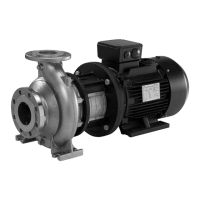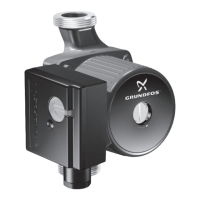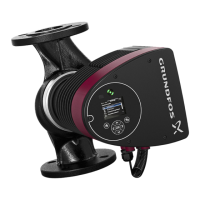English (GB)
28
16. Fault finding
Warning
Before removing the terminal box cover
and before removing/dismantling the
pump, make sure that the power supply
has been switched off and that it cannot be
accidentally switched on again.
Fault Cause Remedy
1. Pump delivers no
or too little liquid.
a) Wrong electrical connection
(2 phases).
Check the electrical connection and remedy, if
necessary.
b) Wrong direction of rotation. Interchange two phases of the power supply.
c) Air in suction pipe. Vent the suction pipe or the pump.
d) Counter-pressure too high. Set the duty point in accordance with the data
sheet. Check the system for impurities.
e) Inlet pressure too low. Increase the liquid level on the suction side. Open
the isolating valve in the suction pipe. Make sure
that all the conditions in section 8.6 Pipework are
complied with.
f) Suction pipe or impeller
blocked by impurities.
Clean the suction pipe or pump.
g) Pump draws in air due to
defective seal.
Check the pipeline seals, pump housing gaskets
and shaft seals, and replace, if necessary.
h) Pump draws in air due to
low liquid level.
Increase the liquid level on the suction side and
keep it as constant as possible.
2. Motor-protective
circuit breaker has
tripped because
the motor is
overloaded.
a) Pump blocked by impurities. Clean the pump.
b) Pump running above rated
duty point.
Set the duty point in accordance with the data
sheet.
c) Density or viscosity of liquid
higher than specified when
ordering.
If less flow is sufficient, reduce the flow on the
discharge side. Or fit a more powerful motor.
d) Motor-protective circuit
breaker overload setting
incorrect.
Check the setting of the motor-protective circuit
breaker and replace, if necessary.
e) Motor runs on two phases. Check the electrical connection. Replace the fuse,
if defective.
3. Pump makes too
much noise.
Pump runs
unevenly and
vibrates.
a) Inlet pressure too low
(cavitation).
Increase the liquid level on the suction side. Open
the isolating valve in the suction pipe. Make sure
that all the conditions in section 8.6 Pipework are
complied with.
b) Air in suction pipe or pump. Vent the suction pipe or the pump.
c) Counter-pressure lower
than specified.
Set the duty point in accordance with the data
sheet.
d) Pump draws in air due to
low liquid level.
Increase the liquid level on the suction side and
keep it as constant as possible.
e) Impeller out of balance
(clogged impeller blades).
Clean and check the impeller.
f) Inner parts worn. Replace the defective parts.
g) Pump stressed by pipework
(thus causing starting
noise).
Mount the pump so that it is not stressed.
Support the pipes.
h) Defective bearings. Replace the bearings.
i) Defective motor fan. Replace the fan.
j) Foreign bodies in pump. Clean the pump.
k) Frequency converter
operation.
See section 10.2 Frequency converter operation.

